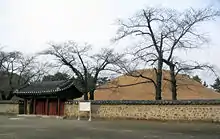Michu of Silla
Michu of Silla was the thirteenth ruler of the Korean state of Silla (r. 262–284). He was the first king of the Kim clan to sit on the Silla throne; this clan would hold the throne for most of Silla's later history. He was the son of Gudo, a leading Silla general, and the sixth-generation descendant of the clan founder Kim Alji.
| Michu of Silla | |
 Tomb of King Michu located in the neighborhood of Hwangnam-dong, Gyeongju, North Gyeongsang province, South Korea.[1] | |
| Korean name | |
|---|---|
| Hangul | 미추 이사금 |
| Hanja | 味鄒尼師今 |
| Revised Romanization | Michu Isageum |
| McCune–Reischauer | Mich'u Isagŭm |
| Monarchs of Korea |
| Silla |
|---|
| (Pre-unification) |
|
During Michu's reign, the Samguk Sagi reports numerous attacks from Baekje, and does not mention any contact with the other neighboring states.
Michu's tomb is preserved in central Gyeongju today. Various legends pertain to this burial mound, which is known as the Jukjangneung, or "Bamboo chief tomb."[2]
Achievement
Although records of his era are not abundant, he seemed to have large interests on agriculture. In 264, he visited the peasant people to encourage them during a severe famine. In 268, subjects were dispatched by Michu to hear concerns of people.
Additionally, he was quite compassionate in that he turned down the requirement of rebuilding palaces for the reason that the people shouldn't labor too much.
Legend
It is a legend that the spirit of King Michu helped Silla and protected the country by appeasing the spirit of Kim Yu-sin, who unified the Three Kingdoms. During the reign of King Yurye of Silla, people from Iseoguk (伊西國) attacked Gyeongju, and Silla was powerless. Then, soldiers with bamboo leaves in their ears appeared and turned the state of war around. After the enemy's retreat, a pile of bamboo leaves piled up in front of the tombs of the King Michu. So, the tomb of Michu was called Jukhyeongneung or Jukjangneung, meaning "the tomb of bamboo generals." [2]
See also
- Three Kingdoms of Korea
- Rulers of Korea
- History of Korea
- List of Korea-related topics
References
- (in Korean) 신라미추왕릉 新羅味鄒王陵 Archived 2011-06-10 at the Wayback Machine Nate / Encyclopedia of Korean Culture
- "미추왕죽엽군설화(未鄒王竹葉軍說話) - 한국민족문화대백과사전". encykorea.aks.ac.kr (in Korean). Retrieved 2018-05-13.
Michu of Silla Died: 284 | ||
| Regnal titles | ||
|---|---|---|
| Preceded by Cheomhae |
Ruler of Silla 262–284 |
Succeeded by Yurye |